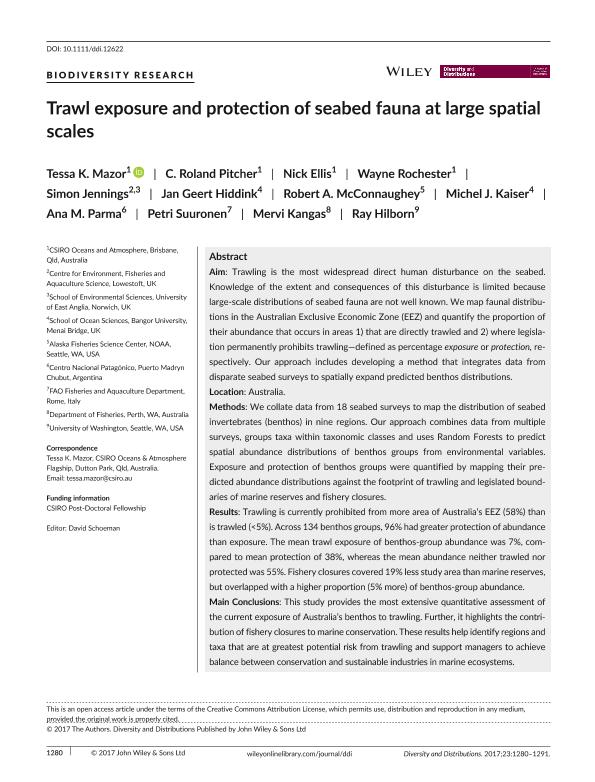Mostrar el registro sencillo del ítem
dc.contributor.author
Mazor, Tessa K.
dc.contributor.author
Pitcher, C. Roland
dc.contributor.author
Ellis, Nick
dc.contributor.author
Rochester, Wayne
dc.contributor.author
Jennings, Simon
dc.contributor.author
Hiddink, Jan Geert
dc.contributor.author
McConnaughey, Robert A.
dc.contributor.author
Kaiser, Michel J.
dc.contributor.author
Parma, Ana María

dc.contributor.author
Suuronen, Petri
dc.contributor.author
Kangas, Mervi
dc.contributor.author
Hilborn, Ray
dc.date.available
2018-05-29T20:08:00Z
dc.date.issued
2017-11
dc.identifier.citation
Mazor, Tessa K.; Pitcher, C. Roland; Ellis, Nick; Rochester, Wayne; Jennings, Simon; et al.; Trawl exposure and protection of seabed fauna at large spatial scales; Wiley Blackwell Publishing, Inc; Diversity and Distributions; 23; 11; 11-2017; 1280-1291
dc.identifier.issn
1366-9516
dc.identifier.uri
http://hdl.handle.net/11336/46510
dc.description.abstract
Aim: Trawling is the most widespread direct human disturbance on the seabed. Knowledge of the extent and consequences of this disturbance is limited because large-scale distributions of seabed fauna are not well known. We map faunal distributions in the Australian Exclusive Economic Zone (EEZ) and quantify the proportion of their abundance that occurs in areas 1) that are directly trawled and 2) where legislation permanently prohibits trawling—defined as percentage exposure or protection, respectively. Our approach includes developing a method that integrates data from disparate seabed surveys to spatially expand predicted benthos distributions. Location: Australia. Methods: We collate data from 18 seabed surveys to map the distribution of seabed invertebrates (benthos) in nine regions. Our approach combines data from multiple surveys, groups taxa within taxonomic classes and uses Random Forests to predict spatial abundance distributions of benthos groups from environmental variables. Exposure and protection of benthos groups were quantified by mapping their predicted abundance distributions against the footprint of trawling and legislated boundaries of marine reserves and fishery closures. Results: Trawling is currently prohibited from more area of Australia´s EEZ (58%) than is trawled (<5%). Across 134 benthos groups, 96% had greater protection of abundance than exposure. The mean trawl exposure of benthos-group abundance was 7%, compared to mean protection of 38%, whereas the mean abundance neither trawled nor protected was 55%. Fishery closures covered 19% less study area than marine reserves, but overlapped with a higher proportion (5% more) of benthos-group abundance. Main Conclusions: This study provides the most extensive quantitative assessment of the current exposure of Australia´s benthos to trawling. Further, it highlights the contribution of fishery closures to marine conservation. These results help identify regions and taxa that are at greatest potential risk from trawling and support managers to achieve balance between conservation and sustainable industries in marine ecosystems.
dc.format
application/pdf
dc.language.iso
eng
dc.publisher
Wiley Blackwell Publishing, Inc

dc.rights
info:eu-repo/semantics/openAccess
dc.rights.uri
https://creativecommons.org/licenses/by/2.5/ar/
dc.subject
Australian Benthic Fauna
dc.subject
Benthic Invertebrates
dc.subject
Fisheries Management
dc.subject
Fishery Closures
dc.subject
Marine Conservation
dc.subject
Marine Reserves
dc.subject
Species Distribution Modelling
dc.subject
Trawl Fisheries
dc.subject.classification
Otras Ciencias Biológicas

dc.subject.classification
Ciencias Biológicas

dc.subject.classification
CIENCIAS NATURALES Y EXACTAS

dc.title
Trawl exposure and protection of seabed fauna at large spatial scales
dc.type
info:eu-repo/semantics/article
dc.type
info:ar-repo/semantics/artículo
dc.type
info:eu-repo/semantics/publishedVersion
dc.date.updated
2018-05-22T21:45:50Z
dc.journal.volume
23
dc.journal.number
11
dc.journal.pagination
1280-1291
dc.journal.pais
Reino Unido

dc.journal.ciudad
Londres
dc.description.fil
Fil: Mazor, Tessa K.. CSIRO; Australia
dc.description.fil
Fil: Pitcher, C. Roland. CSIRO; Australia
dc.description.fil
Fil: Ellis, Nick. CSIRO; Australia
dc.description.fil
Fil: Rochester, Wayne. CSIRO; Australia
dc.description.fil
Fil: Jennings, Simon. University of East Anglia; Reino Unido. Fisheries and Aquaculture Science; Reino Unido
dc.description.fil
Fil: Hiddink, Jan Geert. Bangor University; Reino Unido
dc.description.fil
Fil: McConnaughey, Robert A.. National Ocean And Atmospheric Administration. Alaska Fisheries Science Center; Estados Unidos
dc.description.fil
Fil: Kaiser, Michel J.. Bangor University; Reino Unido
dc.description.fil
Fil: Parma, Ana María. Consejo Nacional de Investigaciones Científicas y Técnicas. Centro Científico Tecnológico Conicet - Centro Nacional Patagónico; Argentina
dc.description.fil
Fil: Suuronen, Petri. Fisheries and Aquaculture Department; Italia
dc.description.fil
Fil: Kangas, Mervi. Department of Fisheries Perth; Australia
dc.description.fil
Fil: Hilborn, Ray. University of Washington; Estados Unidos
dc.journal.title
Diversity and Distributions

dc.relation.alternativeid
info:eu-repo/semantics/altIdentifier/doi/https://dx.doi.org/10.1111/ddi.12622
dc.relation.alternativeid
info:eu-repo/semantics/altIdentifier/url/https://onlinelibrary.wiley.com/doi/abs/10.1111/ddi.12622
Archivos asociados
